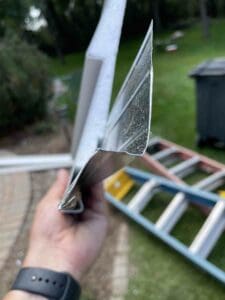Some people look at vinyl siding with skepticism but that’s because they may have never seen a great vinyl siding job. More especially, one where the installer pays attention to details.
Quality and Accessories
Quality: Vinyl siding can be an affordable luxury product or it can just be cheap. Prices can vary and more often than not, you get what you pay for. When I talk about details I’m referring to whether or not a company uses the recommended accessories.
Vinyl Siding Accessories: So what are these accessories? First you have to understand how vinyl siding comes together. A special trim piece called a j-channel goes around windows and the siding slides into that channel, giving it a finished look. The j-channel gets nailed directly onto the exterior sheathing, then siding fits into it, concealing the cut edge.
Expansion Rates
One thing to understand about vinyl siding is that it is really just the skin on a house. It is not like paint or wood. It is meant to expand and contract with the temperatures. In fact, sometimes, more especially on southern exposures, you can hear vinyl siding making small little crackle sounds, similar to the snap-crackle-pop of rice crispies, when it is in direct sunlight. This is the siding naturally expanding and contracting. The j-channel makes it so that an expansion or contraction of the siding panel itself, will still be concealed behind the “J”.
Hoses can use split blocks which have a built in j-channel. Much better than caulk, which doesn’t like to expand or contract nearly at the rate that vinyl siding does, a split block works great to take up that expansion.
Understanding expansion is key in understanding a good vinyl siding install. First, all vinyl will expand in hot weather and contract in cold weather. Darker colors will expand even more than medium or neutral tones. A j-channel, j-block or split block will have a deep enough j-channel to accommodate the expansion and contraction of your siding.

Best Practices
All siding interlocks. The bottom course is typically started with a starter course. This can be either vinyl or steel. A steel starter is nailed to the building. After that the bottom of the first course of siding gets pulled up to lock into the bottom course. Each subsequent course interlocks into a bend or hem piece on the top of each piece of siding.
You’ll notice that siding has expansion and contraction lines for the nails to go into on the top of each piece. When properly installed, the nails are not nailed tight. This allows the siding to constantly slide across those nails as it expands and contracts as long as it is on your house. Siding with foam backing which is attached by a glue or lamination process, is less likely to have great swings in the amount of expansion and contraction because there is no empty void behind the siding which can act as a green house and heat up.
Excessive heat can prematurely break down vinyl siding, causing it to become chalky or brittle prematurely. A good quality vinyl siding, well installed, can last in excess of 50 years and beyond, requiring only a power washing every decade or two on the north side which never sees sun and, like trees which have moss on the north side, tends to sometimes get algae marks. These can easily be washed off.
Looking for a siding contractor with a guarantee? Click here to learn more.



